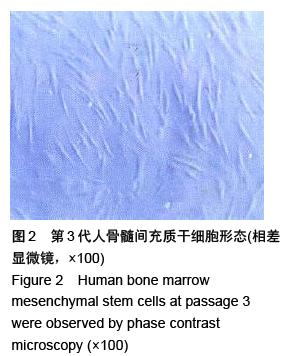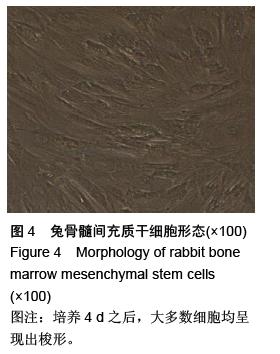| [1] Tian HT,Yang SH,Xu L,et al. Chondrogenic differentiation of mouse bone marrow mesenchymal stem cells induced by cartilage-derived morphogenetic protein-2 in vitro. J Huazhong Univ Sci Technolog Med Sci. 2007;27(4): 429-432.[2] 石正松,李强,蔡伟良,等.腺病毒介导hBMP-2转染BMSCs复合DBM修复兔缺血性股骨头坏死的实验研究[J].天津医药,2015,43(10):1128-1132.[3] 蔡峰,韦继南,谢鑫荟,等.基质细胞衍生因子-1/趋化因子受体4信号轴调控骨髓间充质干细胞在退变椎间盘中迁移[J].中华实验外科杂志,2015,32(4):843-846.[4] 管大凡,刘洪美,张聪,等.骨形态发生蛋白2/血管内皮生长因子165转染骨髓间充质干细胞复合多孔纳米羟基磷灰石/聚酰胺66修复兔桡骨缺损[J].中华创伤杂志,2015, 31(4): 353-359. [5] 崔颖,王月田,姚梅,等.以转染CDMP1基因的BMSCs修复软骨缺损[J].基础医学与临床,2013,33(4):450-457.[6] 崔颖,马林祥,朱丽明,等.CDMP和TGF联合诱导BMSCs修复软骨缺损[J].基础医学与临床,2011,31(2):155- 160.[7] 徐斌,周亮,王英明,等.同种异体脱钙骨与骨髓间充质干细胞关节腔内共培养:与同腔软骨性状的对比[J].中国组织工程研究,2014, 18(8):1165-1171.[8] Schagemann JC, Paul S, Casper ME, et al. Chondrogenic differentiation of bone marrow-derived mesenchymal stromal cells via biomimetic and bioactive poly-ε-caprolactone scaffolds. J Biomed Mater Res A. 2013;101(6):1620-1628.[9] Iwai R, Kumagai Y, Fujiwara M, et al. Combination of cytomegalovirus enhancer with human cellular promoters for gene-induced chondrogenesis of human bone marrow mesenchymal stem cells. J Biosci Bioeng. 2010;110(5): 593-596.[10] 杨大鉴,黄定强,胥方元,等.骨髓间充质干细胞-支架复合体向软骨诱导分化的实验研究[J].泸州医学院学报,2005, 28(5): 394-396.[11] 蔺文魁,马敬.骨髓间充质干细胞分离扩增与诱导分化的研究进展[J].临床军医杂志,2014,42(3):291-295.[12] Zhu S, Zhang B, Man C, et al. Combined effects of connective tissue growth factor-modified bone marrow-derived mesenchymal stem cells and NaOH-treated PLGA scaffolds on the repair of articular cartilage defect in rabbits. Cell Transplant. 2014;23(6): 715-727.[13] Fu WL, Zhou CY, Yu JK. A new source of mesenchymal stem cells for articular cartilage repair: MSCs derived from mobilized peripheral blood share similar biological characteristics in vitro and chondrogenesis in vivo as MSCs from bone marrow in a rabbit model. Am J Sports Med. 2014;42(3):592-601.[14] Qi BW, Yu AX, Zhu SB, et al. Chitosan/poly(vinyl alcohol) hydrogel combined with Ad-hTGF-β1 transfected mesenchymal stem cells to repair rabbit articular cartilage defects. Exp Biol Med (Maywood). 2013;238(1):23-30.[15] 孙安科,李万同,孟庆延,等.带蒂肌筋膜瓣充填与包裹构建喉支架形态组织工程软骨[J].中华耳鼻咽喉头颈外科杂志, 2011,46(12):1019-1023.[16] 崔颖,王宏,徐天睿,等.人胚胎关节软骨来源的间充质干细胞[J].北京大学学报:医学版,2004,36(3):281-286. [17] 庞永刚,崔鹏程,陈文弦,等.人骨髓间质干细胞作为骨、软骨组织工程种子细胞的实验研究[J].细胞与分子免疫学杂志,2004,20(3):306-309.[18] Sato Y, Wakitani S, Takagi M.Xeno-free and shrinkage-free preparation of scaffold-free cartilage-like disc-shaped cell sheet using human bone marrow mesenchymal stem cells. J Biosci Bioeng. 2013;116(6):734-739.[19] Chong PP, Selvaratnam L, Abbas AA, et al. Human peripheral blood derived mesenchymal stem cells demonstrate similar characteristics and chondrogenic differentiation potential to bone marrow derived mesenchymal stem cells. J Orthop Res. 2012;30(4): 634-642.[20] 赵可庆,翟立杰,王志强,等.基因芯片筛选骨髓间充质干细胞与透明软骨细胞的差异表达基因[J].大连医科大学学报,2008,30(5):405-409.[21] 崔翔,侯瑞霞,李群,等.壳聚糖在喉软骨组织工程中的应用[J].组织工程与重建外科杂志,2015,11(3):208-212.[22] Mimura T, Imai S, Okumura N, et al. Spatiotemporal control of proliferation and differentiation of bone marrow-derived mesenchymal stem cells recruited using collagen hydrogel for repair of articular cartilage defects. J Biomed Mater Res B Appl Biomater. 2011; 98(2):360-368.[23] Truong MD, Chung JY, Kim YJ, et al. Histomorphochemical comparison of microfracture as a first-line and a salvage procedure: is microfracture still a viable option for knee cartilage repair in a salvage situation. J Orthop Res. 2014;32(6):802-810.[24] Wang W, Li B, Li Y, et al. In vivo restoration of full-thickness cartilage defects by poly(lactide-co- glycolide) sponges filled with fibrin gel, bone marrow mesenchymal stem cells and DNA complexes. Biomaterials. 2010;31(23):5953-5965.[25] Cao L, Yang F, Liu G, et al. The promotion of cartilage defect repair using adenovirus mediated Sox9 gene transfer of rabbit bone marrow mesenchymal stem cells. Biomaterials. 2011;32(16):3910-3920.[26] Wang W, Li B, Li Y, et al. In vivo restoration of full-thickness cartilage defects by poly(lactide-co-glycolide) sponges filled with fibrin gel, bone marrow mesenchymal stem cells and DNA complexes. Biomaterials. 2010;31(23):5953-5965.[27] 陆达锴,沈志森,侯瑞霞,等.喉软骨支架结构与构建的研究进展[J].北京生物医学工程,2014,33(2):191-196. |
.jpg)

.jpg)


.jpg)
.jpg)